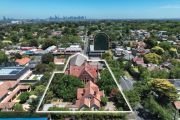
Investment bankers’ top property picks for 2024
Data centres and rental housing are shaping up as the hot tips for commercial property investment in 2024, with inflation-beating returns keenly sought from a sector still battling the effect of high interest rates, top real estate investment bankers say.
With rates relief unlikely before the second half of the year, further pressure is expected for the traditional staples of commercial property, office and retail. That makes the hunt for rental growth that can outpace inflation even more intense in 2024 and takes it into areas once considered niche, say a panel of four leading property bankers in a virtual roundtable convened by The Australian Financial Review.

“Both the data centre sector and the various residential sub-sectors, including manufactured housing, seniors living, student accommodation and build to sell/rent, display characteristics of strong growth outlooks and are likely to be preferred sectors for investors in 2024,” said Ben Connolly, managing director and head of real estate Citi, Australia & New Zealand.
Manufactured housing, also known as land lease, is an emerging sector where residents buy a pre-fabricated home and pay ground rent for a site. Along with other forms of accommodation, it should benefit from strong demand as Australia navigates an anticipated housing shortfall. Self-storage and logistics facilities – which still command substantial rental growth – were also favoured by the bankers’ roundtable.
Also worth noting, in the view of veteran banker Tim Church, Morgan Stanley co-head of investment banking, Morgan Stanley Australia, was the fact that listed real estate investment trust sector had been beaten down to bargain pricing after almost two years of turmoil.
“Bombed-out REITs that have suffered from a combination of poor sentiment and rising bond yields and cash rate increases look decidedly good value, ie oversold, particularly when you consider that we are closer to – if not there already – peak interest rates,” he said.

There were some signs in the final months of last year that the REIT sector may be bouncing back as yields on long-dated bonds – a key determinant of value – finally eased lower, sparking a surge in property stocks.
While REIT stocks were sold down significantly two years ago by nervy investors as bonds began rising, the process of devaluation has taken longer to flow into the pricing of portfolios and unlisted assets, as transactions slowed in the direct market.
The slow-moving devaluation of commercial property assets had still some way to play out in 2024, the bankers said.
Office towers values are most at risk, as weak demand and hybrid work arrangements create more uncertainty. Colliers have forecast values could fall 10-15 per cent further, for a total loss of 25 per cent peak-to-trough.
Capitalisation rates, or cap rates, are the industry shorthand for assessing value, similar to an investment yield. As cap rates rise, values usually fall, unless offset by rental growth. Listed landlords such as Dexus slashed the value of their office holdings through 2023, as they recorded higher cap rates.
On Monday, Cromwell wiped 7.5 per cent from the value of its office portfolio, a fall that covered the last six months.

Ben Boyd, managing director and head of real estate at MA Moelis Australia, expected cap rates to rise higher yet, putting pressure on values.
“The rest of the REITs are expected to show similar upward trends as they announce results in February. I think most in the market expect cap rates to continue to move upwards in 2024,” Mr Boyd said.
“The big questions which will ultimately drive cap rates in 2024 are: ‘Have interest rates peaked?’ And if so, ‘when will they start to come down and how quickly?’
“Unless we see interest rates starting to move down in first half of 2024, and continuing through the second half, valuation cap rates will continue to be challenged. Assets with above-inflation rental growth may be able to hold valuation however, with rental growth offsetting cap rate increases.”
Those battered balance sheets have held the listed REITs back as they battle for opportunity and ownership against the might of private capital – super funds, sovereign wealth and private equity players.

Australia’s biggest superannuation funds have flagged their intention to ramp up investments in local unlisted assets as higher interest rates force more owners to sell.
“It’s not an exaggeration to say that Australia’s capital markets are undergoing historic shifts with the growth of private capital – both equity and credit,” said Mitchell Schauer, managing director, head of real estate investment banking, Jarden.
“For context, Australian super funds manage around $3.5 trillion in assets, which is more than the combined market value of all companies listed on the ASX (about $2.5 trillion).
“From one perspective, long-duration private capital is best suited to develop and own commercial real estate. But the liquidity, transparency, and equity raising efficiency in public markets is valuable and critical for well-functioning, vibrant companies and economies.”

The relative strengths, and constraints, of private and public capital have spurred a push in by the listed REITs to go ‘capital light’, using their platforms to manage funds from private capital, according to Mr Schauer.
But the pressure on REITs and the power of private capital could also spur more mergers and acquisitions in 2024, as the prospect of capital raisings and IPOs by REITs in the public market diminishes.
“We expect corporate activity to be more elevated as we’ve hit peak rates and prices have not recovered sufficiently,” Morgan Stanley’s Mr Church said.











